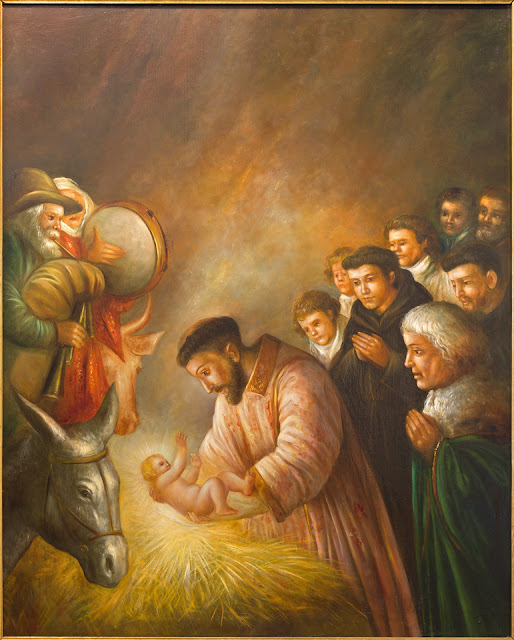First Nativity Scene by St Francis
Image: modern painting of St. Francis of Assisi in the Scene of Nativity, by an unknown artist of the XXth century. Church di Santo Anchel, at a Capuchin Convent.
The Nativity scenes or Births have been a popular Advent and Christmas decoration for centuries and, like most glorious, consecrated and holy things, originated with a Catholic saint: Saint Francis of Assisi.
Francisco had a special devotion to the Child Jesus, and he is credited with creating the first Nativity scene on Christmas Eve in 1223.
It is believed that San Francisco was inspired by this idea for the first time after visiting the historical place of the birth of Christ during a pilgrimage to the Holy Land: the humble stable of a cave in Bethlehem. It is likely that this event has helped deepen his devotion to the Infant Jesus, who was born in the world with such poverty, humility and simplicity. In fact, Francisco founded his new religious Order to imitate these virtues.
The first scene of the Nativity. San Francisco recreated the scene of the birth of Christ with a very special ceremony, which included the Holy Mass and celebrated inside a cave in Greccio, Italy, and to which he invited his brothers and the townspeople.
He installed an empty manger (the farm animal feeder that served as Jesus' cradle) inside a cave, and even included a live ox and a donkey next to the manger, as it was believed to have happened that first Christmas night. Through these visual aids, he wanted everyone to impress more deeply in his understanding of how Christ came into the world in such poverty and simplicity. This was a typical perspective of the unique charism of St. Francis of simple spirituality centered on poverty.
It is also said that San Francisco, which was radically dedicated to the virtue of evangelical poverty, was inspired to recreate the original nativity scene to overcome unbridled greed and materialism prevailing at that time in Italy.
This image is a public domain image, which means either that copyright has expired in the image or the copyright holder has waived their copyright. Franciscan Gallery charges for the access to high resolution copy of the image. Manually restoration was necessary in order to improve quality, without covering the original image.






Thank you St Francis for introducing the BELEN and the lessons derived in meditating on it- the humility, simplicity and poverty of our incarnate God.
ReplyDelete